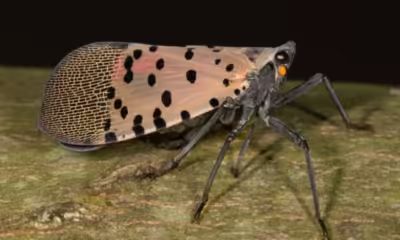Blog
Canada Lynx Sighting in Vermont : A Sign of Wildlife Resurgence?

Introduction
In recent years, the elusive Canada lynx has made its presence known in Vermont, raising questions and excitement among wildlife enthusiasts and biologists alike. The once-endangered species, known for its tufted ears and powerful hunting abilities, has been spotted in the forests of the Green Mountain State, a region not typically associated with this majestic predator. But what does this sighting mean for Vermont’s ecosystem, and is it a sign of the lynx population recovery in the Northeast? Let’s dive into the story of the Canada lynx in Vermont.
The Importance of Canada Lynx in Vermont
The Canada lynx is a medium-sized wildcat with unique adaptations that allow it to thrive in cold, snowy environments. Its large, padded paws enable it to easily walk across deep snow, and it has a specialized relationship with its primary prey: the snowshoe hare. However, over the years, the Canada lynx has faced numerous challenges, particularly due to habitat loss and hunting.
Vermont, known for its dense forests and cold winters, has historically not been a primary habitat for the Canada lynx. These cats were much more common in the northern reaches of the United States and across Canada. But with changing environments and conservation efforts ramping up, lynx sightings in Vermont have become more frequent, suggesting a possible range expansion.
So why is this significant?
- Biodiversity: The presence of the Canada lynx in Vermont signals a healthy and diverse ecosystem. Predators play a critical role in maintaining the balance of prey species, preventing overpopulation of animals like the snowshoe hare.
- Environmental Indicator: Because lynx rely on large tracts of unbroken forest to thrive, their return indicates that Vermont’s wilderness is robust enough to support large predators.
Recent Lynx Sightings in Vermont
Over the past few years, several Canada lynx sightings have been reported in Northeast Vermont, particularly near Montgomery and in the Northeast Kingdom. These sightings have been confirmed by local wildlife biologists, who have found evidence of lynx tracks, fur, and even camera trap footage.
| Location | Year of Sighting | Evidence |
|---|---|---|
| Northeast Kingdom | 2020 | Tracks, camera trap |
| Montgomery | 2021 | Fur, tracks |
| Green Mountain National Forest | 2022 | Visual confirmation |
The Role of Conservation Efforts in Vermont
Historically, the Canada lynx has been listed as threatened under the Endangered Species Act. While the species isn’t native to Vermont, recent efforts by both state and federal organizations have made a difference in supporting this predator’s population growth.
Key Conservation Efforts
- Lynx Monitoring Programs: In Vermont, wildlife biologists have initiated lynx tracking programs to monitor the animal’s movements and identify its preferred habitats.
- Habitat Preservation: Efforts to preserve large tracts of unbroken forests in Northeast Vermont have been critical. These forests not only support the Canada lynx, but also other species like the snowshoe hare and various bird species.
- Collaborations with Canada: Given that Vermont is adjacent to Canada, collaboration with Canadian wildlife officials has been essential in understanding how lynx migrate between the two regions.
Lynx Habitat and Range Expansion in Vermont
The Canada lynx primarily inhabits boreal forests characterized by dense evergreen trees, cold climates, and deep snow. However, as climate conditions shift and forests in Vermont continue to mature, the lynx habitat is expanding southward.
Why is Vermont Suitable?
- Dense Forests: Vermont’s unbroken tracts of forests provide the ideal environment for lynx, who are secretive and avoid open areas.
- Snowshoe Hare Abundance: The lynx’s primary food source, the snowshoe hare, is abundant in Vermont, providing a sustainable food supply for the growing lynx population.
Fun Fact: Canada lynx have a nearly 10-year cycle tied to the population of snowshoe hares. As hare populations boom, so does the lynx population, and Vermont seems to be on the edge of this cyclical growth.
Lynx vs. Bobcat: How to Tell the Difference
Both the Canada lynx and the bobcat are common wildcats in the northern forests of North America. However, Vermont is home to both species, making it important to understand the key differences between these two animals, especially as sightings increase.
| Feature | Canada Lynx | Bobcat |
|---|---|---|
| Size | Slightly larger, about 24 lbs | Smaller, around 18 lbs |
| Tail | Short, with a black tip | Short, with black and white tip |
| Ear Tufts | Long and prominent | Shorter and less visible |
| Feet | Larger, snowshoe-like paws | Smaller, not as adapted to snow |
The lynx’s larger size and snowshoe-like paws are its standout features, allowing it to walk on snow with ease compared to the bobcat.
Real-Life Example: The Montgomery Sighting
In 2021, a local hiker in Montgomery, Vermont, stumbled upon Canada lynx tracks in the snow. Initially unsure of what the tracks belonged to, the hiker contacted the Vermont Fish and Wildlife Department, who confirmed that the tracks belonged to a Canada lynx.
This sighting, followed by camera trap footage from the area, marked one of the most significant lynx sightings in Vermont. It has since sparked increased interest from the scientific community and local wildlife enthusiasts, leading to more lynx monitoring programs.
The Ecological Impact of Lynx Returning to Vermont
The return of the Canada lynx to Vermont isn’t just a win for wildlife enthusiasts—it’s a key indicator of the health of the state’s ecosystems. As a top predator, the lynx helps maintain the balance of smaller mammal populations, particularly the snowshoe hare, which can reproduce rapidly if not kept in check.
Ecological Benefits:
- Control of Snowshoe Hare Populations: Lynx prey almost exclusively on snowshoe hares, preventing hare overpopulation, which could otherwise lead to habitat degradation.
- Boost in Biodiversity: The presence of the lynx signifies that Vermont’s forests can support diverse wildlife, from predators to prey species.
- Tourism and Education: Increased lynx sightings could lead to eco-tourism opportunities in Vermont, as people come to the state to catch a glimpse of this rare predator.
Challenges Facing Canada Lynx in Vermont
While the recent sightings of the Canada lynx are exciting, there are still challenges that this species faces in Vermont.
- Climate Change: As winters in Vermont become shorter and less severe, the deep snow that Canada lynx rely on may decrease, making it harder for them to compete with other predators like bobcats.
- Habitat Fragmentation: Urban development and deforestation can reduce the large, unbroken forests that the lynx need to thrive.
- Human Interference: As sightings increase, so does the potential for human-lynx interactions, which could lead to unintentional harm to these animals.
Conclusion
The Canada lynx sightings in Vermont represent more than just a fleeting moment of wildlife magic—they are a testament to the conservation efforts and the health of Vermont’s ecosystems. As these sightings become more frequent, it is clear that Vermont is playing an important role in the potential range expansion of this fascinating species.
However, challenges remain. From climate change to habitat fragmentation, the future of the Canada lynx in Vermont will depend on continued efforts to preserve and protect the Vermont wilderness that these majestic cats call home.
In the coming years, will Vermont become a permanent home for the Canada lynx, or are these sightings just a temporary occurrence? Only time will tell, but for now, it’s a wildlife success story worth celebrating.
Summary of Key Points:
- Canada lynx sightings in Vermont have increased in recent years, particularly in the Northeast Kingdom and Green Mountain regions.
- The presence of lynx signifies a healthy ecosystem with abundant prey like the snowshoe hare.
- Conservation efforts and habitat preservation have played a critical role in supporting lynx populations.
- Vermont’s forests offer a promising habitat, but climate change and human interference pose challenges for the long-term survival of the Canada lynx in the state.
-

 Sport4 months ago
Sport4 months agoIs Christie Sides Married? Exploring the Personal Life of a Renowned Basketball Coach
-

 Food5 months ago
Food5 months agoNew Restaurants in Canton, CT – 2024
-

 Blog4 months ago
Blog4 months agoSimone Biles Biological Parents: Understanding Her Journey
-

 Blog4 months ago
Blog4 months agoUnleash Your Potential at FBYANA Fitness Indonesia Gym
-

 Sport4 months ago
Sport4 months agoSimone Biles Husband Height: A Closer Look at the Athlete’s Power Couple
-

 Food5 months ago
Food5 months agoWhat Gives Amber Ale Its Sweet Flavor?
-

 Celebrity4 months ago
Celebrity4 months agoLarsa Pippen Before and After: A Deep Dive into Her Transformation Over the Years
-

 Celebrity4 months ago
Celebrity4 months agoBianca Censori Spotted Shopping Solo in Beverly Hills: A Style Icon in the Making?

















